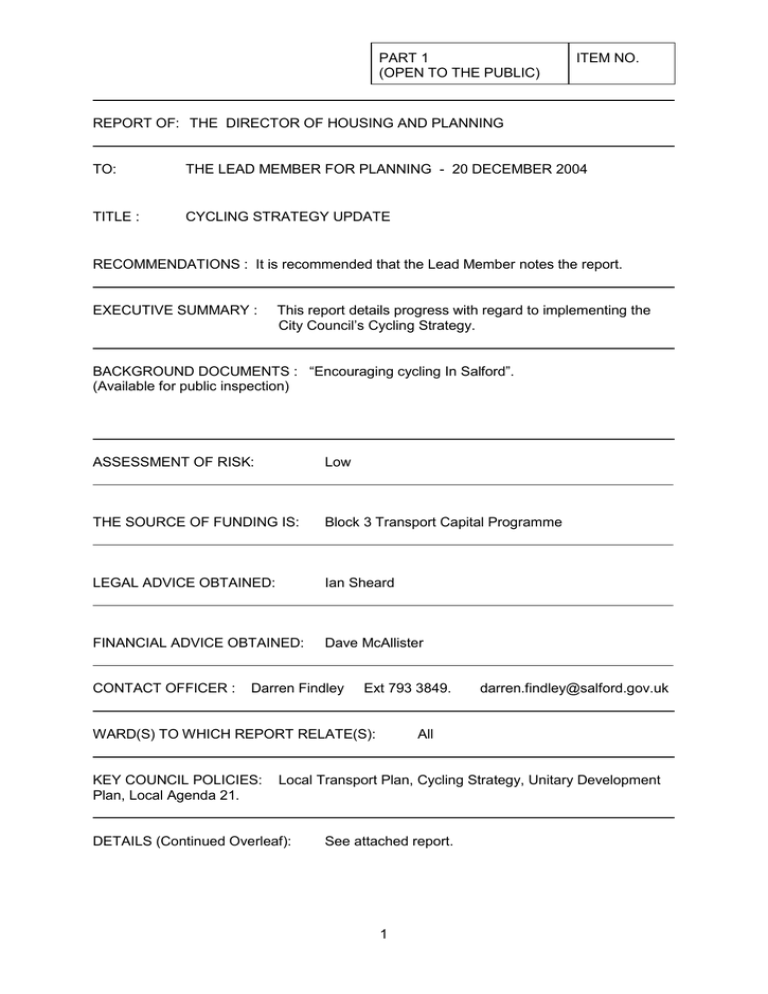PART 1 ITEM NO. (OPEN TO THE PUBLIC)
advertisement

PART 1 (OPEN TO THE PUBLIC) ITEM NO. REPORT OF: THE DIRECTOR OF HOUSING AND PLANNING TO: THE LEAD MEMBER FOR PLANNING - 20 DECEMBER 2004 TITLE : CYCLING STRATEGY UPDATE RECOMMENDATIONS : It is recommended that the Lead Member notes the report. EXECUTIVE SUMMARY : This report details progress with regard to implementing the City Council’s Cycling Strategy. BACKGROUND DOCUMENTS : “Encouraging cycling In Salford”. (Available for public inspection) ASSESSMENT OF RISK: Low THE SOURCE OF FUNDING IS: Block 3 Transport Capital Programme LEGAL ADVICE OBTAINED: Ian Sheard FINANCIAL ADVICE OBTAINED: Dave McAllister CONTACT OFFICER : Darren Findley Ext 793 3849. WARD(S) TO WHICH REPORT RELATE(S): KEY COUNCIL POLICIES: Plan, Local Agenda 21. darren.findley@salford.gov.uk All Local Transport Plan, Cycling Strategy, Unitary Development DETAILS (Continued Overleaf): See attached report. 1 Introduction: 1. The Lead Member will recall that the City Council’s Cycling Strategy, “Encouraging cycling In Salford”, was successfully launched on the 9th December last year, and received much praise amongst the region’s cycling fraternity. The key objectives of the strategy, as stated within the document, are to: increase the safety of cyclists; develop a network of safe cycle routes and provide secure parking facilities; promote the greater use of cycles, by making cycling more attractive for all age groups; contribute to an improved environment, by seeking to alleviate urban pollution and congestion by encouraging cycling as a serious means of daily transport; promote a transport system which benefits our collective health; ensure sufficient financial resources are made available to implement the strategy; and ensure the Local Cycling Strategy is fully integrated into the Unitary Development Plan. 2. In order to implement the strategy effectively, the following key areas were identified for attention: Cycle route network Accident prevention Cycle parking Integration with public transport Cycle audit Development control Recreational cycling Maintenance Schools and education Encouragement Regional Benchmarking: 3. During 2004, the City Council has participated in the North West Regional Cycling Benchmarking Project. This project brought together several authorities from across the region, to visit each other and gather knowledge of what each authority was doing with regard to cycling development and promotion, and to identify any significant good practice that might be worthy of wider dissemination. Participating authorities included: Bolton, Bury, Halton, Manchester, Salford, Sefton, Stockport, Warrington, Wigan and Wirral. 4. The process identified a number of interesting ideas and concepts across the region, and also put the quality of Salford’s own cycling facilities into some form of perspective. At Salford’s hosting, many visitors were pleasantly surprised at the sheer extent and quality of cycling facilities provided throughout the City. 2 5. Aspects receiving particular praise included: our widening of bridges to accommodate cycle lanes, the good continuity of cycle route provision, bus stop bypasses for cyclists, and good partnership working. Constructive criticism included: uneasiness regarding the cycle lane lining on the Irlams O’th Height Roundabout, the large number of “Cyclists Dismount” signs, obstructions within the shared-use facilities, and the limited cycling publicity and promotion undertaken by the Council. Cycle Route Network: 6. The City Council has continued to implement new cycling facility schemes, in developing and expanding its cycle route network. Recent schemes include the Barton Cycling Facilities and the two Sustrans Routes (NCN6 & NCN55). Accident Prevention: 7. Cycling casualties in Salford have steadily reduced compared to the 94-98 average, although 2003 saw a slight increase compared to 2002. The Council’s Neighbourhood Road Safety Initiative bid includes a sum of £50,000 to train instructors to encourage safer cycling amongst Salford children. Cycle Parking: 8. This year, the City Council commenced a rolling programme of cycle parking provision. The intention is to establish a high level of convenient cycle parking facilities throughout Salford over the next few years. In addition, sheltered parking is also proposed for the Civic Centre, which will be the subject of a separate report to Lead Member. Integration with Public Transport: 9. The main issue for Salford here will be to push for more and better cycle parking provision at train and Metrolink stations. This can be pursued as part of the GMPTE’s Station Development Zones initiative. Cycle Audit & Development Control: 10. Since the publishing of the City Council’s Cycling Strategy, the AGMA authorities have jointly introduced the Concise Pedestrian and Cycle Audit (COPECAT), which comprises a system of audit intended to ensure that all new highways, town planning and proposed developments take into consideration the needs of cyclists and pedestrians. The Council’s strategy document includes the COPECAT checklists as appendices. It will be important to ensure that all council processes related to highways, planning and development control have the COPECAT audit system incorporated into the relevant QA procedures. 3 Recreational Cycling: 11. Discussions have recently been held between the City Council and Sustrans, with regard to the development of two Sustrans routes through Salford. NCN Route 6 will link Manchester & Bury. This route will aim to follow the bank of the River Irwell, where practical, and pass by or through the Islington Estate, Trinity, Salford University, Charlestown, and up to Agecroft. The route will require the extension and upgrading of the riverside walkways in the vicinity of the Littleton Road Playing Fields. NCN Route 55 will link Manchester and Wigan, utilising Liverpool Street, Eccles New Road, Ellesmere Park, Monton and the Looplines towards Leigh, which will require some degree of renovation in certain locations. Maintenance: 12. Maintenance of cycle routes continues, and the City Council’s website now includes a facility which enables the public to register highway faults on-line, such as potholes or broken glass. Schools and Education: 13. Cycle training and road safety education continues to be provided for schools throughout the City. A theory lesson is presented to Year 4 pupils, which includes information on: cyclist vulnerability; correct cycle size; maintenance; protective clothing; helmets; observations; and signals. Cycle training is offered to all Primary Schools. During 2004, the Road Safety Unit carried out 57 courses, with 608 pupils successfully completing the training. Encouragement: 14. Jointly with Cycling Projects, the City Council is developing a system of “Bike Stations”. This facility will enable local residents to borrow bikes on a daily basis, free of charge. Users will be required to register, in much the same way as they might to become library members. These facilities will also be of great benefit and use by the Primary Care Trust, and enable it to establish its proposed “cycling for health” service. Again, this Bike Station initiative will be the subject of a separate, more detailed report to Lead Member in due course. 15. Neil Harvey, the head organiser of Nation Bike Week, attended the City Council’s Cycle Forum meeting of the 7th December 2004. The aim is to organise some kind of event for Salford in June 2005. “In Town Without My Car Day”, ITWMC Day, will be held across the whole of Europe on 22nd September 2005, and there has been a proposal to arrange something jointly with Manchester City Council, possibly involving road closures in the Deansgate, Blackfriars Street area to accommodate a large, cross-boundary street market. 4 Monitoring: 16. Generally speaking, cycle use is difficult to monitor, since daily flow counts can be influenced significantly depending on weather conditions. To help alleviate this problem, the City Council has commissioned GMTU to install three new Automatic Cycle Counters (ACCs), which monitor cycle flows throughout the year. These will be installed at the following sites: - Princes Bridge; - South Langworthy Road, adjacent to the Metrolink Station; & - Liverpool Road, Irlam. English Regions Cycling Development Team (ERCDT): 17. The English Regions Cycling Development Team (ERCDT) was establish by the DfT during 2002, to assess and advise local authorities on their performance with regard to provisions for cyclists. The ERCDT’s current contract will expire in May 2005, however, the DfT have decided not to renew or extend it. Conclusion: 18. Since the launch of the City Council’s Cycling Strategy, in December 2003, there has been a number of significant developments with regard to cycling projects, schemes and initiatives. In particular, the regional benchmarking project has been very helpful in terms of the Council gaining new ideas from other authorities and receiving good praise and encouragement, as well as some valuable constructive criticism, of the Council’s existing provision for cyclists. Malcolm Sykes Strategic Director of Housing and Planning 5


